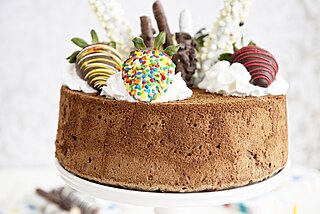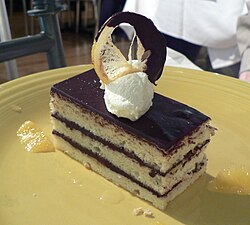
Cake is a flour confection made from flour, sugar, and other ingredients and is usually baked. In their oldest forms, cakes were modifications of bread, but cakes now cover a wide range of preparations that can be simple or elaborate and which share features with desserts such as pastries, meringues, custards, and pies.

Pastry is baked food made with a dough of flour, water, and shortening that may be savoury or sweetened. Sweetened pastries are often described as bakers' confectionery. The word "pastries" suggests many kinds of baked products made from ingredients such as flour, sugar, milk, butter, shortening, baking powder, and eggs. Small tarts and other sweet baked products are called pastries as a synecdoche. Common pastry dishes include pies, tarts, quiches, croissants, and pasties.

Angel food cake, or angel cake, is a type of sponge cake made with egg whites, flour, and sugar. A whipping agent, such as cream of tartar, is commonly added. It differs from other cakes because it uses no butter. Its aerated texture comes from whipped egg white. Angel food cake originated in the United States and first became popular in the late 19th century. It gained its unique reputation along with its name due to its light and fluffy texture.

Pound cake is a type of cake traditionally made with a pound of each of four ingredients: flour, butter, eggs, and sugar. Pound cakes are generally baked in either a loaf pan or a Bundt mold. They are sometimes served either dusted with powdered sugar, lightly glazed, or with a coat of icing.

Cheesecake is a dessert made with a soft fresh cheese, eggs, and sugar. It may have a crust or base made from crushed cookies, graham crackers, pastry, or sometimes sponge cake. Cheesecake may be baked or unbaked, and is usually refrigerated.

Devil's food cake is a moist, rich chocolate layer cake. It is considered a counterpart to the white or yellow angel food cake. Because of differing recipes and changing ingredient availability over the 20th century, it is difficult to precisely qualify what distinguishes devil's food from the more standard chocolate cake. However, it traditionally has more chocolate than a regular chocolate cake, making it darker in colour and with a heavier texture. The cake is usually paired with a rich chocolate frosting.

Icing, or frosting, is a sweet, often creamy glaze made of sugar with a liquid, such as water or milk, that is often enriched with ingredients like butter, egg whites, cream cheese, or flavorings. It is used to coat or decorate baked goods, such as cakes. When it is used between layers of cake it is known as a filling.

Lemon ice box pie is an icebox pie consisting of lemon juice, eggs, and condensed milk in a pie crust, frequently made of graham crackers and butter. It is a variant of key lime pie; in both, the citric acidity sets the egg yolks, with minimal baking. There are also no bake versions.

Quick bread is any bread leavened with a chemical leavening agent rather than a biological one like yeast or sourdough starter. An advantage of quick breads is their ability to be prepared quickly and reliably, without requiring the time-consuming skilled labor and the climate control needed for traditional yeast breads.

Hot milk cake is a butter sponge cake from American cuisine. It can be made as a sheet cake or a layer cake, or baked in a tube pan. The hot milk and butter give the cake a distinctive fine-grained texture, similar to pound cake.

A butter cake is a cake in which one of the main ingredients is butter. Butter cake is baked with basic ingredients: butter, sugar, eggs, flour, and leavening agents such as baking powder or baking soda. It is considered one of the quintessential cakes in American baking. Butter cake originated from the English pound cake, which traditionally used equal amounts of butter, flour, sugar, and eggs to bake a heavy, rich cake.

A génoise, also known as Genoese cake or Genovese cake, is a French sponge cake named after the city of Genoa and associated with French cuisine. It was created by François Massialot in the late 17th century. Instead of using chemical leavening, air is suspended in the batter during mixing to provide volume.

Lane cake, also known as prize cake or Alabama Lane cake, is a bourbon-laced baked cake traditional in the American South. It was invented or popularized by Emma Rylander Lane (1856-1904), a native and long-time resident of Americus, Georgia, who developed the recipe while living in Clayton, Alabama, in the 1890s. She published the original recipe in Some Good Things to Eat (1898). Her original recipe included 8 egg whites, 1 cup butter, 1 cup sweet milk, 2 cups sifted sugar, 3 ¼ cups sifted flour, 2 teaspoons baking powder, 1 tablespoon vanilla and called for the layers to be baked in pie tins lined with ungreased brown paper rather than in cake pans. The filling called for 8 egg yolks, 1 cup of sugar, 1/2 cup butter, 1 cup seeded raisins, 1 wine-glass of whiskey or brandy, and 1 teaspoon vanilla.

Buttercream, also referred to as butter icing or butter frosting, is used for either filling, coating or decorating cakes. The main ingredients are butter and some type of sugar.

Kue is an Indonesian bite-sized snack or dessert food. Kue is a fairly broad term in Indonesian to describe a wide variety of snacks including cakes, cookies, fritters, pies, scones, and patisserie. Kue are made from a variety of ingredients in various forms; some are steamed, fried or baked. Kue are popular snacks in Indonesia, which has the largest variety of kue. Because of the countries' historical colonial ties, Koeé (kue) is also popular in the Netherlands.

Foam cakes are cakes with very little fatty material such as butter, oil or shortening.

Sponge cake is a light cake made with egg whites, flour and sugar, sometimes leavened with baking powder. Some sponge cakes do not contain egg yolks, like angel food cake, but most of them do. Sponge cakes, leavened with beaten eggs, originated during the Renaissance, possibly in Spain. The sponge cake is thought to be one of the first non-yeasted cakes, and the earliest attested sponge cake recipe in English is found in a book by the English poet Gervase Markham, The English Huswife, Containing the Inward and Outward Virtues Which Ought to Be in a Complete Woman (1615). Still, the cake was much more like a cracker: thin and crispy. Sponge cakes became the cake recognised today when bakers started using beaten eggs as a rising agent in the mid-18th century. The Victorian creation of baking powder by English food manufacturer Alfred Bird in 1843 allowed the addition of butter to the traditional sponge recipe, resulting in the creation of the Victoria sponge. Cakes are available in many flavours and have many recipes as well. Sponge cakes have become snack cakes via the Twinkie.
Bumpy Cake was created by Sanders Confectionery, of Detroit, Michigan, in the early 1900s and was known as "The Sanders Devil's Food Buttercream Cake" when it was first introduced. It is made of chocolate devil's food cake that is topped with rich buttercream bumps, and then draped in a chocolate ganache. Now more than a century old, this is a classic confection.

The old-fashioned doughnut is a term used for a variety of cake doughnut prepared in the shape of a ring with a cracked surface and tapered edges around it. Nineteenth century recipes for "old-fashioned donuts" are made with yeast, but in modern doughnut shops an "old-fashioned doughnut" is usually a cake doughnut. Cake doughnuts made with chemical leavener originated in the United States circa 1829. Primary ingredients in the old-fashioned doughnut include flour, sugar, butter, eggs, sour cream or buttermilk, and chemical leavener. It is typically deep fried, may have a crunchier or crisper texture compared to other styles of cake doughnuts, and typically has cracks and pores on its surface. After being fried, it is glazed, dusted with sugar, or served plain.

Ube cake is a traditional Filipino chiffon cake or sponge cake made with ube halaya. It is distinctively vividly purple in color, like most dishes made with ube in the Philippines.





















